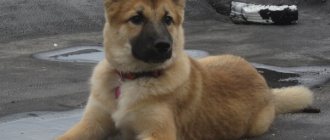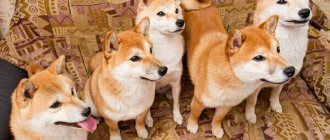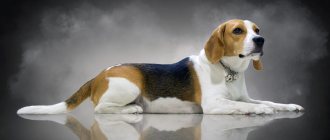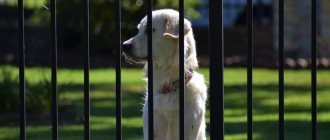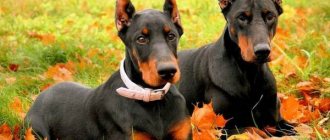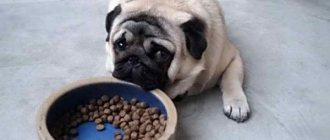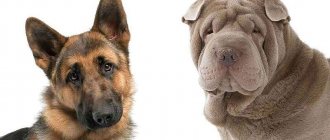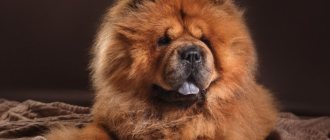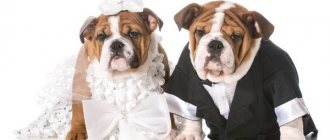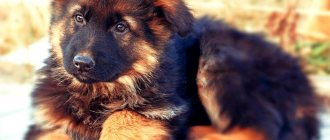The basic requirements for hunting dogs are strength, endurance, courage, devotion, and obedience. Raising and training such breeds differs from training ordinary domestic dogs.
Hunting dogs must be prepared to go without food for a long time in different climatic conditions. When choosing a suitable breed, it is recommended to pay attention to what animals the dogs are capable of tracking. The sociable qualities of an animal are also important, because a dog becomes a reliable partner for a person during a hunt.
Kurzhaar
The shorthaired pointer is a famous hunting breed bred in Germany. She is intelligent, quick-witted and amenable to training. These dogs require a lot of physical activity.
The breed is characterized by loyalty, friendliness towards the owner and family members, high performance and excellent watchdog qualities. It is easy to train a dog to be clean and tidy. The shorthaired pointer is used for hunting birds, hares, deer, and raccoons.
Representatives of the breed are excellent swimmers and perform the “fetch” command well. Dogs require constant training; they are ready to learn new things and easily master commands. The main thing in keeping a Shorthaired Pointer is to organize daily walks with minimal physical activity to maintain muscle tone.
Large and medium terriers
This group of dogs has its own characteristic features - overflowing energy, assertiveness, perseverance to the point of stubbornness, courage and a penchant for noisy games. All these qualities in terriers are organically combined with devotion to the owner, lively character and excellent learning abilities.
Border Terrier
This dog reaches a quarter of a meter at the withers and is golden, fawn, gray or red in color. The breed was developed in Great Britain. Representatives have a balanced character, good spirits, perseverance and patience. They are sociable, friendly towards people, and have a lively mind. The Border Terrier is good-natured towards children and does not require any special conditions. On walks he shows himself to be a true hunter, chasing cats, and at home as a favorite of all family members.
Bedlington Terrier
The Bedlington Terrier's coat can be sandy or blue. The size of the dog grows to 0.4 meters at the withers. This breed, with a representative exterior, was bred in England. A distinctive feature is the thick and curly coat.
This dog is able to show vigilance when protecting the territory, dexterity in games and hunting, as well as affection and complaisance when communicating with its owner. The characteristic features of this breed include mobility and restlessness, courage and moderate viciousness. The Bedlington Terrier successfully masters the training course and enjoys interacting with people.
Brazilian Terrier
The Brazilian Terrier can have spots of different colors on a white background: red, dark, or blue. The name of the breed indicates that it was bred in Brazil. Representatives of this type of terrier have a friendly disposition, easily adapt to life in city apartments, having a size at the withers of up to 0.4 measures. Such dogs become very loyal friends and love affection, willingly play with children, and love to frolic at any age. They are distinguished by good learning ability and easy-going disposition.
Welsh Terrier
Representatives of this breed grow 39 centimeters at the withers and have a red or dark saddle coat. The breed was developed in Wales (England).
These four-legged animals are characterized by determination on the verge of recklessness, irrepressible courage, temperament and liveliness of character. Welsh is a typical representative of burrow hunters, capable of being persistent in relation to prey. At the same time, the dog is very loyal to humans, gets great pleasure from communication, loves fun games, gives affection to the owner and strives to protect him.
Irish Terrier
The homeland of these dogs is Ireland.
The size can be up to 45 centimeters. The Irish Terrier is particularly devoted to its owner; at the same time, these animals are capable of hunting on their own. They are very smart, have a good memory and incredible learning abilities. To get a manageable and well-mannered dog, training should begin as early as possible. The Irish can exhibit an obstinate disposition, combined with an irrepressible temperament, so it is necessary to educate him persistently and consistently.
These terriers are cocky and look for a reason to measure their strength; with great pleasure they take part in hunting, where they can show their warlike inclinations. Although it is possible to raise an Irish Terrier not only to be a hunter, but also to be a charming companion or athlete.
Kerry Blue Terrier
The maximum height of these representatives of the breed reaches half a meter at the withers. As the name suggests, the dog's color is "blue", although sometimes the head can be dark in color. The breed was developed by Irish dog breeders and has a stable nervous system, despite its temperament and restlessness.
This dog is smart and highly trainable. Such a terrier is capable of becoming an excellent watchman, has the makings of a vigilant guard and protector, is attached to the owner and, as a rule, is friendly towards other people. This dog knows how to win over others and easily makes contact.
Manchester Terrier
Like most terriers, Manchester was bred in England. According to the norm, at the withers it should reach 40 centimeters. This dog has a kind, flexible character.
Manchester Terriers are distinguished by their cleanliness. These dogs are fond of children, willingly play games and are open to communication. At the same time, they do not lose their vigilance and are constantly on the alert.
Despite the enormous energy that overwhelms him, the terrier is not aggressive, and he does not have the habit of biting someone. Training this dog is not difficult, even for inexperienced dog breeders.
Smooth Fox Terrier
Foxes are predominantly white in color with dark and red spots on the skin located in the head and tail area. This breed appeared in England. The dog has such qualities as an active spirit, mobility, and fearlessness.
The Fox Terrier copes well with its duties during the hunt, in which it is helped by assertiveness and courage. The dog knows how to pick up the right scent and tirelessly pursue its prey. The strong character of a dog imposes special requirements on its upbringing; without proper training, it can become stubborn and uncontrollable. A competent approach will ensure harmonious interaction with a person.
Fox Terrier Wirehaired
The wire-haired Fox Terrier is similar in color to the smooth-haired Fox Terrier and has approximately the same dimensions, about 0.4 meters at the withers.
These dogs require special care for their coat, because it needs trimming, i.e. plucking old fur. The Fox Terrier has a special character, he is independent and active, these dogs have an inquisitive mind and good vigilance. Hunting for them is a passion of their whole life, which they are ready to indulge in with gusto. The terrier is courageous and prone to showdowns with other four-legged representatives. Such a dog needs a competent owner who can consistently educate it, extinguish outbursts of anger and manage the dog’s energy, directing it in a positive direction.
Airedale
Airedale Terriers are among the largest representatives of their section, their size reaches 0.6 meters at the withers. The color is predominantly brownish-red. The homeland of the Airedale Terrier is in the British Isles. He bears the unspoken title of the king of terriers.
Representatives of this breed are strong and active, have a muscular body and a cheerful disposition. Airedale Terriers are distinguished by confident behavior, constant vigilance and stable functioning of the nervous system. These dogs are well trained, hardy and patient, which allows them to use their abilities in a wide variety of directions. They become excellent watchdogs, sensitive assistants to blind people, effective search investigators, rescuers and cheerful companions, always open to communication.
Labrador Retriever
The breed has a water-repellent coat and webbed feet. Thanks to these characteristics, the Labrador Retriever swims well, so it is taken to hunt ducks, pheasants, grouse, and woodcock. Dogs have a gentle bite, so they practically do not damage their prey.
In the 18th century, Labradors were used by fishermen to collect their catch from nets. The breed is characterized by an athletic build, energy, good disposition, friendliness, and obedience.
Features of duck hunting
Duck hunting is common among hunters of all levels. But you also need to know the peculiarities of this fishery. The spring duck hunting period lasts about two weeks, after which you can hunt only from mid-August to the end of October. In spring you can only hunt drakes. This can be done in several ways - the first is approach hunting. The hunter looks for where the ducks live and, with the help of the dog, raises the game, shoots it, and his faithful assistant brings the prey.
Duck hunting from a porch differs only in that the hunter waits for the game, waiting in the boat. There must be experienced dogs here, because too old or young dogs, experiencing the excitement of the hunt, may not calculate their strength and drown.
Migration hunting includes feeding birds: in the evening, ducks fly to the field to feed, and in the morning they return to their pond. If you shoot a duck in a field, then most likely the flock will change its feeding location and they will need to be tracked again, so you need to shoot the game in the middle of the field and the pond. Here the dog will help find wounded animals and bring back prey.
There are also other types of waterfowl hunting: shooting from a hut or hunting with a decoy duck, but in such cases the use of dogs is infrequent, because here you need to have patience and not every one of them is able to wait and not scare the duck ahead of time.
Beagle
The peculiarity of the breed lies in its specific ringing bark and compact size. The dog is non-aggressive and howls loudly when in danger. The Beagle has a good sense of smell, a cheerful disposition, and high energy.
These dogs have a stubborn character, so they require special training and good discipline. The Beagle is distinguished by its friendliness, ease of care, cleanliness, endurance, and intelligence. He gets along well with the owner, children and pets.
The breed is a universal hunting dog, so it can be used to track rabbits, foxes, pheasants, and quails. A flock of beagles can be used when hunting large animals, wild boars, roe deer, and jackals.
Bull Terriers
This subspecies constitutes a special group that appeared as a result of crossing English bulldogs with terriers. From the former, these beautiful animals inherited extraordinary power and an iron grip, and from the latter they inherited an explosive temperament, physical mobility, and hunting passion.
American Staffordshire Terrier
This terrier can grow up to 46 centimeters.
It has a predominantly white color. This type of dog was bred in the United States of America. The Staffordshire Terrier is friendly towards people, loves to interact with children, and often initiates games and entertainment. Representatives of this breed are strong, resilient, active and athletic. With qualified and regular training, the pet does not show signs of excessive aggression and can become a pleasant companion.
Bull Terriers
A tough and strong dog. He is brave and has a clear instinct to guard the territory and protect the owner from danger. At the same time, such a dog requires the approval of the owner in order to feel calm and confident.
The Bull Terrier has established itself as a worthy comrade and reliable friend. Proper training helps the dog have a friendly attitude towards people.
The size of the dog varies from 55 to 33 centimeters. England is the birthplace of this breed, representatives of which can have a variety of colors. The Miniature Bull Terrier is a mini version of the standard one, borrowing the most positive character traits. He is flexible, active and full of joy, which he generously shares with others.
Staffordshire Bull Terrier
This dog also comes from Albion.
Initially, they participated in dog fighting, for this reason they have a muscular body and a cool disposition. Nowadays the Bull Terrier is more friendly towards people. It has a special attachment to its owner. Due to its nature, raising such a dog requires professionalism, literacy, perseverance and patience.
English pointer
The Pointer combines the characteristics of hounds, greyhounds and hunting dogs. The breed is distinguished by its strength, high energy, persistence and endurance, making it ideal for hunting.
The pointer can dive and is able to pursue prey for a long time, so it is used when hunting birds and hares. He is also characterized by good eyesight, search skills, attentiveness, and a keen sense of smell.
When the dog notices prey, he freezes, and his body stretches out, pointing at the victim. The dog has an instant reaction, friendliness, and loyalty. The Pointer loves being surrounded by people and does not show aggression.
Read The best dogs for children - top 20 breeds
Pointing hunting dogs
The purpose of cops is to hunt various birds. Able to smell and track game in any weather conditions. They hunt waterfowl, marsh and field birds. They have a very good sense of smell, capable of leading a dog to a target even over a wide area.
When a pointer has found prey, it stands in a characteristic pose, showing its owner where the game is. She then rushes towards the birds and forces them to fly. And the hunter can only shoot.
Common pointers are the drathaar, shorthaired pointer, and English setter:
- Drathaar. Their qualities as a hunter are innate, so there is no need for special training. Animals are strong and resilient. Dogs love to hunt, even bad weather and hunger do not stop them. Drathaar is also an excellent swimmer and is not afraid of cold water. And the fetch knows the team better than all other breeds.
- Kurzhaar is active and smart. Shows good professional qualities in the open field. Notifies the hunter with a stand about the found prey.
- Setters are considered cops. For example, English and Irish. They are able to smell the game, even if it is far from the hunter. Take a stance, stretching out the tail like a string and raising one paw, and standing with the head in the direction of the game. They can stand like this until the hunter shoots the prey. They are able to run fast and get through the densest thickets.
Fox terrier
The breed was bred for fox hunting, but now its scope has expanded significantly. The Fox Terrier is distinguished by its compact size, endurance and good eyesight. It can sit in a small den for a long time, waiting for prey, and then instantly chase it.
The dog is taken to hunt birds, foxes, raccoons, and badgers. The peculiarity of the breed is its good grip. Although the Fox Terrier is small in size, its fangs are not inferior to large dogs. Once a dog has caught prey, it will not let it go.
Possible diseases
The Jagd Terrier breed is one of those lucky breeds that do not carry virtually any genetic diseases. Of course, this does not mean that the owner has the right to calm down and forget the address of the veterinary clinic. Even these “tough nuts” can sometimes catch a cold, get hurt, or be poisoned by something. In any case, if your pet suddenly becomes uninterested in the world around him, he lies down and refuses to eat, you need to contact a specialist.
Self-medication and indifference to the dog’s health will sooner or later lead to its death. Like any other dog, the Jagdterrier requires timely vaccinations, deworming and preventive examinations. Particular attention should be paid to your four-legged friend after returning from hunting. It is necessary to examine his skin for the presence of parasites, scratches and wounds. If the owner notices something serious, there is no point in delaying a visit to the veterinarian.
Weimaraner
The breed is designed for hunting large animals. The dog is also used when catching all game birds. The Weimaraner easily switches from one victim to another.
The Weimaraner is easy to train. Dogs are distinguished by obedience, sensitivity, and good intelligence. The breed is not aggressive, but is wary of strangers.
The Weimaraner is able to sense the mood of its owner, and it is important for him to constantly maintain contact with him. The dog is unpretentious in care: he is content with primitive conditions and simple food. At home, the dog is friendly and gets along well with children.
How to buy a West Highland White Terrier puppy
To buy a purebred West Highland White Terrier, you need to find a good kennel. You can find out about responsible breeders in comments on various sites, reviews or at exhibitions. The nursery provides the necessary documents and veterinary certificates. Such breeders will answer all questions and are ready to advise the new owner after the purchase. It is important to study the pedigrees of the parents, certificates from exhibitions, and the results of genetic testing.
Purebred dogs of this breed in Moscow cost an average of 35-40 thousand rubles. A pet-class puppy with minor defects or hereditary diseases can be purchased for 15-20 thousand rubles.
Before choosing a puppy, you need to evaluate the living conditions of the animals and get to know the mother. Dogs must be clean, cheerful, and not aggressive. The puppy you like should be carefully examined. He should not have discharge from his eyes, bald spots on his fur, or swelling on his stomach. A healthy baby is active, does not smell, his fur is shiny, his nose is moist and cool.
The photo shows what the puppies should look like:
The video complements the description of the breed:
Video: West Highland White Terrier - interesting facts about the breed
Video: 5 features of keeping a West Highland White Terrier
Video: West Highland White Terrier. Pros and cons, price, how to choose, facts, care, history
White terriers are wonderful companions for people who lead an active lifestyle and love sports and hiking. If you give your dog enough attention and raise it correctly, it will become obedient and affectionate. And thanks to her funny appearance and cheerfulness, she won’t let you get bored.
Jack Russell Terrier
The breed is characterized by activity, mobility and endurance. The Jack Russell Terrier is designed for burrow hunting. The dog is compact in size, so it easily penetrates into the dens of foxes and badgers and pulls them out.
The breed is also used when hunting hares, water and ordinary rats, wild boars, roe deer, and deer. The Jack Russell Terrier can navigate well in forested areas, fields and dense thickets. Compact dogs are often used when fighting small rodents and as a watchdog and house dog.
When keeping the breed in an apartment, it is important to organize daily walks and frequent trips to nature, since the active Jack Russell Terrier needs space.
Features of maintenance and care
West Highland White Terriers are indoor dogs. They live quietly in a house or city apartment. Although they are unpretentious and tolerate any weather conditions well. But many owners put clothes on their pets when going outside to keep their fur snow-white.
Due to its small size, the white terrier can be trained to go to the toilet at home using a diaper or litter tray. But it is necessary to take them outside. Adult dogs need to be walked 2-3 times a day for 40-60 minutes. Walks should be active, with outdoor games. Representatives of the breed are ready to run all day, but physical activity should be limited, especially in puppies - this can lead to problems with the joints.
It is recommended to visit parks, dog parks, and take your dog out into nature. But in the city it is better not to let your pet off the leash. A Vestik can dig up a flowerbed or lawn, chase a rat, or wallow in carrion. Interested in an unfamiliar smell, he may run away. Therefore, the dog needs to be loaded with physical and intellectual exercises. Representatives of the breed love to fetch a ball or stick and look for hidden objects.
At home, you need to give your pet a comfortable place away from drafts and heating appliances. There should be soft bedding and a lot of toys so that the dog can entertain himself when he is left alone. Like all terriers, representatives of this breed love to steal small things and hide them in their place.
Grooming
Representatives of this breed are unpretentious and caring for them is not difficult. But to maintain the beauty of its snow-white coat, regular grooming will be required.
Like all wire-haired dogs, the Westie's coat does not shed. The hair falls out, but remains in the coat and falls off. Therefore, these dogs are trimmed regularly. Haircutting is not recommended. After this, the hair becomes soft, begins to curl and fall into tangles. The groomed dog of this breed looks like a lapdog. But some owners who do not show their pets give it haircuts in the summer to make it easier to care for its coat.
You can trim your West Highland White Terrier yourself or go to a grooming salon. It is recommended to do this for an adult dog 3-4 times a year. The first time the procedure is performed is 3-4 months. This will help form the correct silhouette and achieve the multi-layered coat that representatives of the breed should have.
Before the procedure, the hair must be combed well. Using a stripping knife, shorten the hair at the elbows and on the throat. On the back and neck, you need to achieve an even coat 4-5 cm long. On the head and ears, the hair is trimmed by hand. You don't have to touch the limbs. A properly trimmed dog looks attractive: the hair is short on the sides, longer on the chest, and there is a neat mustache and beard on the face.
To care for the West Highland White Terrier, you will also need grooming - regular hygiene procedures.
- You need to bathe your dog once every 1-3 months. These dogs are clean, their coat does not emit a specific odor. You need to use a special shampoo for white wool. It is advisable that it be designed for wire-haired dogs.
- To maintain the whiteness of the wool, places where it turns yellow must be periodically bleached. A mixture of crushed chalk and boric acid is suitable for this. Moisten the wool, rub in the mixture, and then comb out the remaining chalk.
- The dog should be combed 1-2 times a week with a wide-toothed metal comb. Dogs that have their hair cut are brushed more often, as their hair quickly becomes tangled.
- It is recommended to wash your paws after every walk. In rainy weather, it is better to use waterproof clothing so that the dog does not get his belly dirty. In winter, roads are sprinkled with reagents that can corrode the pads, so they must be regularly inspected and lubricated with oil.
- After eating, it is recommended to wipe the face to remove any remaining food. This will help prevent yellowing of the coat and the appearance of an unpleasant odor.
- The hair on the face, paws and under the tail can be trimmed. This will make it easier to keep clean. If the dog is not being shown, it can have decorative haircuts.
- You need to clean your ears once a week. Be sure to pluck the hairs inside the ear, as they impede ventilation and can cause inflammation.
- Wipe your eyes daily. If red streaks appear under them, the dog may have an allergy. It's better to consult a veterinarian.
- You need to brush your pet's teeth a couple of times a week. To prevent tartar, you can give chewing bones and special treats.
- If your pet doesn't walk on the pavement a lot, its claws won't wear down. In this case, it is recommended to shorten them once a month with a nail clipper.
- In the warm season, be sure to treat the coat against external parasites.
Nutrition
You can feed your West Highland White Terrier either dry food or natural food. Usually the feeding method is chosen by the nursery, and then it is not recommended to change it immediately. The transition to another diet should be gradual. An adult dog is fed 2 times a day in small portions. It should not be overfed to prevent weight gain.
It is recommended to choose dry food, this makes it easier to determine the required amount. It should be premium or super premium, designed for active small breed dogs. For dogs with allergies, holistic treatments are more suitable. Premium dry food may contain dyes and additives that change the color of the coat.
When feeding naturally, at least half of the dog’s diet should consist of lean meat. It is mixed with rice or buckwheat porridge and vegetables. It is useful to give your pet fruits and dairy products. You can add fish oil, herbs, and brewer's yeast to your food. Vitamin supplements are given only on the recommendation of a veterinarian. It is advisable not to feed carrots, beets and other foods that can color the coat.
Many Westies are prone to food allergies, so menu planning needs to be done with caution. It is recommended to avoid chicken, wheat and other allergens. You should not give smoked meats, sweets, baked goods, fatty, spicy and salty foods.
Health
West Highland White Terriers live on average 12-14 years. With proper care, a dog can live up to 16 or even 18 years. Representatives of this breed rarely have hereditary pathologies. But there is a tendency to such diseases:
- allergic reactions;
- dermatitis;
- ichthyosis;
- cataract;
- joint dysplasia;
- diabetes;
- meningoencephalitis;
- Perthes disease;
- blood clotting disorder;
- cardiovascular diseases.
Jagdterrier
The breed is intended for hunting foxes, badgers, and raccoons. But the dog is distinguished by its versatility, which is why it is used to catch fur-bearing animals and wild boars. The Jagdterrier has excellent hunting characteristics and follows the blood trail. It is not recommended to use representatives of the breed when hunting rabbits and birds.
Dogs are also weak when chasing through loose snow. The Jagdterrier has a brave, aggressive and malicious disposition, so he never retreats from prey, even if it is several times larger than him. Because of this, dogs are often injured and killed while hunting. Representatives of the breed treat their owner coldly and often ignore his commands.
Main signs and characteristics of hound breeds
This article will consider only the most basic characteristics of breeds in their necessary qualities for hunting. The subtleties of separating different types of hounds are not so significant in hunting practice, although cynologists of hunting societies always try to adhere to the pan-European standard, which helps to maintain the purity, and therefore the remarkable working qualities of the dogs. The main characteristics of a hound: hanging ears, a body of medium massiveness and length with a fairly wide chest, a tucked belly and a straight back, a radish tail, i.e. tapering to the tip without feathering. Most hound dogs are short-haired.
- Ears do not play the main role in searching for animals, so hounds have closed ears that protect the hearing aid from damage. The same can be observed in hunting breeds for waterfowl and burrows. The hound’s main weapon is a subtle sense of smell and tirelessness in searching;
- namely the body, often close to the square type. The “knocked-down block” of this type of dog is an indicator of excellent physical shape. The tucked belly smoothly transitions to the groin without excessive retraction like a greyhound. The chest is wide enough, but not excessively. It is the average width of the body that makes it possible to withstand a strong opponent, while at the same time excessive width would be an obstacle to the speed characteristics of running. Of course, the pursuit speed of greyhounds is much higher; their narrow chest allows for excellent maneuvering while running, which is also inherent in a wolf. Hound breeds do not have the task of catching up with the animal, they only need to drive it out to the hunter. However, a meeting with a hunted animal can turn into a confrontation, which means that some of the fighting qualities must be preserved;
- The height of these dogs varies greatly among different breeds. Dachshund hounds, beagles, and basset hounds have short legs, which allows them to move well in dense thickets and penetrate shelters. Many types of European, English, French breeds, the Russian hound have a taller body and longer limbs. But in any case, the hound must have strong bones, the paw must be dense and elastic for good running. The position of the front shoulder blade is somewhat inclined, which in any hound gives it a slightly inclined silhouette. The hind leg forms an obtuse angle with the underbelly, the so-called “bow”. The body gains the well-known swiftness;
- The second most important quality, after physical form, is the voice. This is a unique quality of these dog breeds. A vyzhlovka or vyzhlovka must have a ringing, sonorous voice with a good timbre, “telling,” as hunters like to characterize it, i.e. heard from afar. In addition to the fact that this is one of the dog’s main tools in work, it is also, according to many fans, a decoration for hunting and communication with autumn nature, creating a certain flavor.
By the voice you can recognize which animal is being led by the survivor, the track or the “sighted” one, the degree of readiness of the animal, you can recognize all stages of the rut.
If the above characteristics and working qualities of a hound largely depend on the purity of the blood, they are inherited, which is a clear illustration of “why you should take a puppy only from purebred parents.” Other qualities of the dog, although they depend on the pedigree, are amenable to training and are brought to perfection with the help of education and training. Flair, tirelessness (tirelessness), viscosity (persistence), porosity (speed of the rut) are inherited. Obedience, loyalty (barking only at the right game), crawling (the ability to find an animal) are among the characteristics that are brought up.
Drathaar
A universal hunting breed that is used to catch game in water and forest. Drathaar has a strong, balanced character and is easy to train.
The dog is assertive, purposeful, courageous, obedient, and quick to react. The dog will not retreat until it brings prey to its owner. The breed is very sociable, therefore it requires constant attention and gets along well with children.
Drathaar is often taken to hunt fur-bearing animals and wild boar. The dog’s tasks include searching for prey (the dog reports the discovery by barking), chasing, driving, distracting the hunter and presenting the carcass. The breed can navigate well in forested areas, but will not climb into thickets.
Read Top 20 largest dogs in the world - large breeds
Main signs and characteristics of hound breeds
This article will consider only the most basic characteristics of breeds in their necessary qualities for hunting. The subtleties of separating different types of hounds are not so significant in hunting practice, although cynologists of hunting societies always try to adhere to the pan-European standard, which helps to maintain the purity, and therefore the remarkable working qualities of the dogs. The main characteristics of a hound: hanging ears, a body of medium massiveness and length with a fairly wide chest, a tucked belly and a straight back, a radish tail, i.e. tapering to the tip without feathering. Most hound dogs are short-haired.
- Ears do not play the main role in searching for animals, so hounds have closed ears that protect the hearing aid from damage. The same can be observed in hunting breeds for waterfowl and burrows. The hound’s main weapon is a subtle sense of smell and tirelessness in searching;
- namely the body, often close to the square type. The “knocked-down block” of this type of dog is an indicator of excellent physical shape. The tucked belly smoothly transitions to the groin without excessive retraction like a greyhound. The chest is wide enough, but not excessively. It is the average width of the body that makes it possible to withstand a strong opponent, while at the same time excessive width would be an obstacle to the speed characteristics of running. Of course, the pursuit speed of greyhounds is much higher; their narrow chest allows for excellent maneuvering while running, which is also inherent in a wolf. Hound breeds do not have the task of catching up with the animal, they only need to drive it out to the hunter. However, a meeting with a hunted animal can turn into a confrontation, which means that some of the fighting qualities must be preserved;
- The height of these dogs varies greatly among different breeds. Dachshund hounds, beagles, and basset hounds have short legs, which allows them to move well in dense thickets and penetrate shelters. Many types of European, English, French breeds, the Russian hound have a taller body and longer limbs. But in any case, the hound must have strong bones, the paw must be dense and elastic for good running. The position of the front shoulder blade is somewhat inclined, which in any hound gives it a slightly inclined silhouette. The hind leg forms an obtuse angle with the underbelly, the so-called “bow”. The body gains the well-known swiftness;
- The second most important quality, after physical form, is the voice. This is a unique quality of these dog breeds. A vyzhlovka or vyzhlovka must have a ringing, sonorous voice with a good timbre, “telling,” as hunters like to characterize it, i.e. heard from afar. In addition to the fact that this is one of the dog’s main tools in work, it is also, according to many fans, a decoration for hunting and communication with autumn nature, creating a certain flavor.
By the voice you can recognize which animal is being led by the survivor, the track or the “sighted” one, the degree of readiness of the animal, you can recognize all stages of the rut.
If the above characteristics and working qualities of a hound largely depend on the purity of the blood, they are inherited, which is a clear illustration of “why you should take a puppy only from purebred parents.” Other qualities of the dog, although they depend on the pedigree, are amenable to training and are brought to perfection with the help of education and training. Flair, tirelessness (tirelessness), viscosity (persistence), porosity (speed of the rut) are inherited. Obedience, loyalty (barking only at the right game), crawling (the ability to find an animal) are among the characteristics that are brought up.
Breton epañol
The pointing breed was bred by the French and was intended for hunting birds that live in the mountains and fields. The Breton Spaniard lends itself well to training, regularly following all the commands of the owner. It is easy to train him to hunt if the task is clearly defined.
The dog has a friendly disposition, high intelligence, energy, sociability and hard work. The Breton Spaniel is not aggressive towards strangers. Representatives of the breed love to please their owner, surprising them with their resourcefulness.
How does the hunt go?
Hare hunting, like any other, takes place according to a certain scenario, which includes:
- preparation process;
- directly hunting.
Preparing for the hunt
Preparation begins with the selection of equipment, checking weapons, ammunition, and everything necessary for hunting.
Find out what shot to use when hunting hare.
Hunting takes place in the cold season - late autumn, early winter, so clothing should be:
- comfortable, durable, practical;
- warm enough not to freeze;
- not too tight so that the hunter does not sweat;
- camouflage.
Hare hunting requires that the hunter will have to walk quite a lot. Therefore, shoes should be extremely comfortable and warm. Don't forget about the headdress. A woolen hat, and in the cold season - a hat with earflaps.
The gun must be carefully checked before going out so that it does not let the hunter down at the right time. The hare cartridges are loaded with shot No. 2-00. The cartridges should be conveniently located in the bandoleer so that the gun can be easily reloaded.
You also need to take water, food, matches. Don't forget the knife - the second main (after a gun) tool of a hunter.
Choosing a hunting location
Hunting, as a rule, takes place in hunting grounds where hares live. The day before the hunt, you should visit the grounds in search of a bedding area. Common hare habitats:
- hayfields;
- fields with winter crops or agricultural products;
- haystacks, thick grass, fallen trees.
Having found fresh traces of the hare, the hunter returns there the next day with a dog to retrieve the prey.
How does the hunt go?
For hunting, choose a cloudy, windless day. The air temperature should not exceed +15 degrees in autumn and -15 degrees in winter. The optimal temperature ranges from +10 to -8 degrees.
Remember! If on a winter morning the temperature on the thermometer is about -20 degrees, but the day promises to be sunny and windless, then in the afternoon the temperature can rise to -6 degrees, which is good for hunting.
The leading role is given to the dog. Only her ability to find a hare, follow the trail and drive it away with a well-aimed shot allows the hunter to return with the prey.
What should a hunter do:
- Get closer to the bed - the raised hare will strive to return to its safe place.
- Choose a place on the leeward side so that nothing interferes with the view.
- Keep your gun at the ready.
- Be extremely quiet, do not smoke.
- When the hare runs out towards the hunter, you should shoot in the body.
Attention! If a dog, while chasing a hare, picks up a bird, you should not shoot it. This will disorient the dog and force it to give up the pursuit.
After the hunter has hunted the hare, it is necessary to drain the blood from it, and also squeeze out the urine by pressing on the stomach. And give the faithful assistant – the dog – the pazankas (hind legs) of a hare as a reward.
Estonian hound
The peculiarity of the breed is its unpretentiousness. The Estonian hound is characterized by endurance and hard work, so it is capable of combing the area for several hours in search of prey. At the same time, the dog is not afraid of dense thickets, dense bushes and large snowdrifts.
The breed is intended for hunting hares. The Estonian hound is actively used to catch quails, pheasants, foxes, wild boars, and roe deer. But if you accustom a dog to ungulates, then it will begin to ignore other game, because roe deer and wild boar are easier to take. The main disadvantages of the breed are a weak voice, excessive courage and ignoring the owner’s commands.
Chasing a hare
Dogs begin preparing for hunting at the age of ten months. The preferred period is spring, since during this period the breeding of hares begins, forest and field paths are covered with odorous secretions. Training should start early in the morning. It should be remembered that in spring and summer, dogs are prohibited in hunting zones. The exception is areas prepared for this.
In the fall, training is also necessary for those dogs that have already been trained and participated in hunting before. During the first hunt, young hounds can be allowed to catch up and fight the hare a little. But under no circumstances should you be allowed to eat it! You can reward your dog with a “pazanka” - a hare’s foot cut off from the prey. This should be done after each successful run.
Dachshund
Nowadays the dachshund is used as a decorative dog. But the breed was bred to hunt foxes in holes. The dog can also be used to catch badgers, raccoons, and small waterfowl.
The dachshund is distinguished by its mobility and activity. The breed has a ringing voice. It is unpretentious to living conditions and tolerates cold and dirt well.
Russian piebald hound
The Russian Piebald Hound is a versatile breed for hunting. It can be used to catch rabbits, foxes, raccoons, wolves and wild boars. It is better to train your dog to catch a specific animal.
If a piebald hound starts catching ungulate animals, then it will not be able to switch to hares and foxes. The dog is characterized by a ringing voice, persistence, endurance, willfulness and excessive gambling.
The breed is capable of chasing prey for several hours, but it often loses contact with its owner, often ignoring his commands. At home, the Russian piebald hound has a friendly and calm disposition.
Dog on hare
Hare hunting is an exciting activity. Especially if you choose a dog suitable for this type of hunting. To keep up with the hare, you need a fast and resilient dog, because the hare, while escaping, continuously changes the trajectory of its movement, thus breaking the pace of its pursuer.
Hounds
Among all breeds, hounds also have such qualities. These dogs are durable, flexible and can develop the necessary speed for a chase. Due to its light weight, the hound can chase its prey for a long time, while other dogs quickly become exhausted. The hound's excellent sense of smell will allow it to instantly find prey.
Of course, any breed of hound dog has characteristic positive and negative qualities. In Russia, three breeds of hounds are in greatest demand: Russian piebald hound, Russian hound and Estonian hound.
The Estonian Hound is popular in its homeland. This dog has average height (up to 52 cm at the withers), which makes it difficult for it to hunt in loose snow and, although it is in no way inferior to other breeds, its low height is the main criterion due to which it is unpopular in Russia.
Russian and Anglo-Russian hounds are almost equivalent in their working characteristics.
One of the factors that gives the Russian Hound an advantage is its lighter weight, which reduces the likelihood of knocking off its paws significantly.
Greyhounds
In addition to hounds, greyhounds and pointing breeds are used. Of course, hunting with a greyhound is different from the same hunting with a hound. The greyhound is much larger and more agile, and its task is to succeed and catch the hare. Usually such hunting is not popular and is called “lazy” or “royal” because the dog does all the work instead of the hunter.
Hunters usually use pointing dogs. The most popular of them are shorthaired pointers and drathaars; they are the most versatile and hunting with them is radically different from hunting with other breeds. Its task is to detect the hare and stand while the hunter chooses the most advantageous position and fires a shot.
These hare hunting dogs are not as effective as hounds. While the pointer makes a stand, the hare can run away and she is unable to chase the hare for a long time.
Hungarian Vizsla
The breed is characterized by intelligence and intelligence. The Hungarian Vizsla is easy to train and quickly learns new commands. The dog has a good sense of smell, loyalty, obedience, and friendliness.
The breed is used for hunting all types of game. But it is best to use the Hungarian Vizsla to catch waterfowl. The dog is an excellent swimmer and copes well with tasks on rough terrain.
Character and psychology
The intelligence and excellent learning ability of this active dog will not leave anyone indifferent.
Among the features are:
- A sharp mind, thanks to which you can quickly train a dog and instill in it the necessary qualities;
- Courage, fearlessness;
- Distrust of strangers. It is important to correctly form the character of the Jagdterrier in order to avoid aggression;
- Endurance, strong constitution;
- He receives extraordinary pleasure from working and executing his master's orders.
Excellent sense of smell allows the Jagdterrier to quickly find prey
Russian-European Laika
The breed is characterized by its compact size, unpretentiousness, activity, endurance, and obedience. The Russian-European Laika does not have a friendly disposition, but it is not aggressive. Representatives of the breed have a complex character and therefore require special training.
The Russian-European Laika is designed for hunting large game: moose, wild boar, bears, wolves. But the dog is also used to catch birds and fur-bearing animals, since the breed is distinguished by its versatility. The dog is well oriented in any area, so it can be taken hunting in the forest, field, river, etc.
Read TOP hairless and hairless dogs - 9 breeds with names
To make the hunt successful
A successful hunt is the result of close interaction between hunter and hound. What is needed for this? Not so much:
Start hunting in the immediate vicinity of the hare's bed. A few circles and loops - and the hare rushes back. That's where you should wait for him. When choosing clothes, consider the color of the environment. The hunter should not stand out against the background of the landscape. All movements should be confident, but unhurried. The hare does not pay attention to static objects
Therefore, waiting near the bed in a motionless stance can lead to the hare itself bumping into you, suspecting nothing. When setting up an ambush, take into account the direction of the wind. Do not stand in the wind; let the hare run out from the leeward side. Make sure the area is clearly visible
You should not be disturbed by grass, bushes, trees, hills, ravines, boulders. If you smoke, give up cigarettes while hunting. Tobacco smoke will give you away to the hare. Carefully study the lifestyle and habits of hares. Remember that the hare and the hare prefer different living conditions.
Rhodesian Ridgeback
The breed is designed for hunting large animals. The Rhodesian Ridgeback was bred in Africa and was used to protect its owner from large animals, including lions.
Dogs are used in hunting bears, wild boars, and game birds. Dogs are distinguished by high intelligence, courage, loyalty, and friendliness. They are able to develop great speed when running. The breed is characterized by excellent hunting and guard qualities.
The Rhodesian Ridgeback gets along well with people and is patient with children. The dog will become a faithful and obedient assistant for every hunter.
Which breed to choose
When choosing a dog for hunting, you need to pay special attention to its temperament and working qualities.
In most dogs, loyalty to their owner is genetic. In professional terms, everything is more complicated: everyone’s purpose is different (again, genetics are to blame). Thus, burrowing dogs are best suited for hunting badgers, pointers are best for hunting birds, and huskies are best suited for hunting bears and wild boars. When choosing a hunting partner, you must remember that a universal dog does not exist.
Bavarian mountain hound
The breed has a calm and balanced character. The Bavarian mountain hound is designed to track wild boars, roe deer and other large animals. But during the hunt, the dog becomes aggressive, courageous and resilient. She is able to follow the trail of a victim for several hours, as she can smell the prey even after a rainstorm.
The breed is characterized by good reaction, strength, and high intelligence. The dog tolerates heat and cold well. The dog is large in size and has an athletic build, so it needs regular physical activity.
West Highland White Terrier Appearance Standard
The West Highland White Terrier is a small dog with a harmonious build. The height of males is on average 28-30 cm, females - up to 26 cm. The weight of dogs does not exceed 10 kg, smaller females weigh 6-7 kg. In appearance, they are a little similar to the Bichon Frize, but are sturdier, stronger and more active.
Head
The head is large, the skull is wide, with prominent brow ridges. The muzzle is of medium length, tapering slightly towards the nose. The bridge of the nose is straight, the stop is sharp, well defined, the lobe is large and black. The jaws are powerful and have a scissor bite. The lips are tightly compressed, dry, black.
The eyes are almond-shaped, set wide and deep. The color of the iris is almost black, the whites are not visible. The look is smart, attentive. The ears are small and erect. They have a triangular shape with sharp tips. Planted close together on the crown of the head.
Frame
The neck is of medium length, muscular, gradually widening towards the body. The body is compact, almost square in shape. The chest is deep, the lower part of the body is level. The back is straight, short, the croup is wide. The tail is straight, of medium length (12-15 cm), held almost vertically. Should not lie on your back or twist.
Limbs
The limbs are straight, short, and muscular. The front ones may be slightly everted, which is due to these dogs' past as burrowers. The thighs are wide, sinewy, and the joints are well defined. The paws are rounded, the toes are clenched. When moving, the dog places its limbs parallel and pushes off powerfully from the ground. She is resilient, runs fast, and can jump high.
Coat and color
The West Highland White Terrier has a medium-length, double coat. The guard hair is straight, hard, shiny and requires regular trimming. The length on the body reaches 5 cm, the longest it is on the stomach. The hair on the head, ears, front surface of the limbs, and tail is shorter. There is a soft, thick undercoat, like fur, that fits tightly to the body. This coat protects the skin from branches, thorns and bad weather.
The color standard for representatives of this breed is only white. There should be no stains. It should be taken into account that the color depends on nutrition and care characteristics. Sometimes the fur may acquire a yellowish tint, and on the mustache and under the eyes it may turn brown.
Photos complement the description of the appearance of West Highland:
Bloodhound
The breed has been used for hunting for more than 300 years. The Bloodhound is vigilant, as it “remembers” the scent of the victim for a long time and is able to track it for several hundred kilometers. Dogs are used in hunting wild boars, moose, badgers and other small animals. The dog reports the capture of the victim with a dull, drawn-out bark. The Bloodhound is best at tracking prey by following its blood trail.
Thanks to their unique skills, dogs are used not only in hunting, but also to search for missing people and criminals. The breed is characterized by friendliness, devotion, and sociability. The Bloodhound loves to be around people and is great with children.
Basenji
A peculiarity of the breed is that at a moment of irritation or anxiety, the dog makes rumbling sounds instead of barking. Dogs have smooth muscles, so they move freely and coordinate their movements well.
The Basenji is distinguished by its mobility, energy, willfulness and excellent hunting skills. In pursuit of game, the dog can ignore the owner's commands.
Representatives of the breed are friendly and sociable. They get along well with people and other pets.
Afghan Hound
The breed is distinguished by its stubborn and freedom-loving disposition. She has a difficult character, but with proper training she will become a reliable and loyal companion. Dogs are frightened by loud noises and love attention and affection.
The Afghan Hound is characterized by sociability, grace, courage, and energy. She always strives to be in the company of people.
The breed has long hair, so it is able to hunt in cold weather. The Afghan Hound has a calm, balanced character and shows virtually no aggression. The dog is used to hunt rabbits, gazelles, foxes, and wolves.
We hope that you were able to determine for yourself the best breed of dog for hunting wild animals! Leave your comments on the article, perhaps we missed other excellent hunters.
Dog on boar
Hunting for wild boar with dogs will be successful when you study all the habits of the animal. The wild boar is a sensitive animal with well-developed hearing and poor eyesight. An important factor will be the help of dogs during hunting; they can be used both collectively and in individual hunting. The dog's task will be to search, call the hunter to the location of the game, search for and pursue wounded animals. Therefore, dogs for hunting wild boar must be smart, passionate, careful, courageous, hardy and trained.
Laika
How to hunt a wild boar without a husky, if it has all the necessary qualities of an assistant? Therefore, you can use any of the huskies for hunting wild boar: West Siberian, Karelian-Finnish, Russian-European, East Siberian. Among huskies, it is best to use the first three listed breeds. The use of these dogs in baiting wild boars can be different; usually the dog is brought to the tract on a leash to the habitat of the animals. A husky taken off a leash quickly detects and pursues a wild boar, barking and biting it, trying to detain one of them until the owner approaches.
Dachshund
Due to their small size, dachshunds are perfect for hunting lops; they are agility and evasive, and do not frighten game too much, which develops a low speed when running away from them. And this gives the hunter a great advantage so as not to miss.
The Latvian Hound has a number of positive qualities. She has a loud voice, with which you can easily locate the dog and prey. Easily detects a trail and finds a wounded animal.
Hunting for wild boar with small dogs, such as Jagdterriers, has a number of advantages: due to the small size of this dog, it is very evasive, its bark is sonorous and loud; hunting passion, fearlessness and dexterity make them good hunting assistants.
According to experienced hunters, there is no ideal dog for hunting wild boars - it all depends on its training and the experience of its owner.

